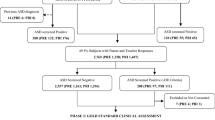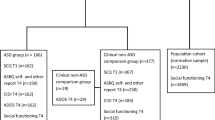Abstract
A follow-up study based on a population survey of children with infantile autism from a northern Swedish county is reported. The original survey was performed during 1977–1979. In the country of Västerbottens 39 cases of “childhood psychosis” were identified in the age group 0–20 years (prevalence 5.6/10,000). According to DSM-III-R, 38 children met the criteria of “autistic disorder”. The follow-up study was performed in 1987–1988, after eight to nine years. Thirty-four individuals participated (20 males and 14 females). Each child was evaluated according to the Medical Research Council's Schedule of Handicaps, Behaviours and Skills, DSM-III-R symptom check-list, Lotter's modified Questionnaire and information about the academic and social situation. Most symptoms showed stability over time. The individuals had a poor outcome. A few, mostly males, improved in function. Only one boy had “grown out of” autism without showing any autistic-like symptoms at all. Four cases, the majority being females, showed a mildly deteriorating course. In one case symptoms of schizophrenia developed. In most children language and communication had improved. The few well-functioning individuals with autism in this study were males. The proportion of severe mental retardation was greater in the female group.
Résumé
Une étude de devenir d'une population d'enfants avec autisme infantile provenant d'un comté de Suède du Nord est rapportée. L'étude originale fut effectuée de 1977 à 1979. Dans le comté de Västerbottens 39 cas de “psychose infantile” furent identifiés dans un groupe d'âge de 0 à 20 ans (prévalence 5.6/10.000). Selon le DSM-III-R 38 enfants répondaient aux critères de “troubles autistiques”. L'étude de sulvi fut effectuée en 1987 et 1988, après 8 à 9 ans. 34 individus ont participé (20 hommes et 14 femmes). Chaque enfant a été évalué selon l'échelle de handicaps du Medical Research Council, comportements et compétences, DSM-III-R Symptom Check-lists, et le questionnaire modifié de Lotter avec enfin une information sur la situation scolaire et sociale. La pluplart des sympômes montraient une stabilité durant le temps des suivis. Les individus avaient un devenir pauvre. Quelques uns, la plupart des garçons, s'amélioraient dans leur fonctionnement. Seulement un garçon était sorti de l'autisme sans montrer aucun symptôme de type autistique. 4 cas, la majorité des filles, montraient un devenir modérément détérioré. Dans un cas, les symptômes de schizophrénie se sont développés. Pour la plupart des enfants, le langage et la communication s'étaient améliorés. Les quelques individus fonctionnant bien avec l'autisme dans cette étude étaient des garçons. La proportion de retard mental sévère était plus grande dans le groups des filles.
Zusammenfassung
Es wurde eine Nachuntersuchung durchgeführt, die auf einer epidemiologischen Untersuchung von Kindern mit infantilem Autismus aus einem nordschwedischen Bezirk basierte. Die Erstuntersuchung erfolgte zwischen 1977 und 1979. In dem Bezirk Västerbottens wurden 39 Fälle von Psychosen im Kindesalter in der Altersgruppe von 0–20 Jahren erfaßt (Prävalenz: 5,6/10.000). 38 Kinder erfüllten die DSM-III-R-Kriterien für eine autistische Störung. Die Nachuntersuchung erfolgte 8–9 Jahre später im Zeitraum von 1987–1988. 34 Individuen (20 männlich, 14 weiblich) nahmen an der Untersuchung teil. Jedes Kind wurde nach den “Medical Research Council's Schedule of Handicaps”, “Behaviours and Skill”, den DSM-III-R-Kriterien, “Lotter's Modified Questionnaire” und anamnestischen Angaben zur akademischen und sozialen Situation untersucht. Die meisten Symptome waren im Verlauf stabil geblieben. Die Prognose erwies sich als insgesamt schlecht. Wenige Kinder, zumeist männlichen Geschlechts, zeigten Funktionsverbesserungen. Lediglich ein Kind war aus dem Autismus “herausgewachsen” und zeigte keinerlei autistische Züge. Vier Fälle (drei weiblich) zeigten einen langsam progredienten Verlauf. In einem Fall stellten sich Symptome einer Schizophrenie ein. In dieser Studie waren die wenigen gut angepaßten Individuen mit Autismus männlichen Geschlechts. Der Anteil an schwerer geistiger Behinderung war beim weiblichen Geschlecht größer.
Similar content being viewed by others
References
American Psychiatric Association (1980).Diagnostic and Statistical Manual of Mental Disorders (3rd. ed., DSM-III). Washington, DC: American Psychiatric Association.
American Psychiatric Association (1987).Diagnostic and Statistical Mannual of Mental Disorders (3rd ed., revised, DSM-III-R). Washington DC: American Psychiatric Association.
Bohman, M., Bohman, I. L., Björck, P. O. & Sjöholm, E. (1983). Childhood psychosis in a northern Swedish county: Some preliminary findings from an epidemiological survey. In M. H. Schmidt & H. Remschmidt (Eds.),Epidemiological Approaches in Child Psychiatry II (pp. 164–173). Stuttgart: Georg Thieme Verlag.
Bohman, M., Bohman, I. L. & Sjöholm-Lif, E. (1988).Childhood psychosis: To identify, understand and treat (in Swedish) (pp. 107–108). Stockholm: Almquist & Wicksell.
Chung, S. Y., Luk, S. L. & Lee, P. W. H. (1990). A follow-up study of infantile autism in Hong Kong.Journal of Autism and Developmental Disorders, 20 221–232.
Clarke, D. J., Littlejohns, C. S., Corbett, J. A. & Joseph, S. (1989). Pervasive developmental disorders and psychoses in adult life.British Journal of Psychiatry, 155, 692–699.
Gillberg, C. & Steffenburg, S. (1987). Outcome and prognostic factors in infantile autism and similar conditions: A population based study of 46 cases followed through puberty.Journal of Autism and Developmental Disorders, 17, 273–287.
Gillberg, C. (1991). Outcome in autism and autistic-like conditions. (1991).Journal of the American Academy of Child and Adolescent Psychiatry, 303, 375–382.
Kobayashi, R., Murata, T. & Yoshinaga, K. (1992). A follow-up study of 201 children with autism in Kyushu and Yamagushi areas, Japan.Journal of Autism and Developmental Disorders, 22, 395–411.
Lotter, V. (1967). Epidemiology of autistic conditions in young children. II. Some characteristics of parents and children.Social Psychiatry, 1, 163–173.
Lotter, V. (1974). Social adjustments and placement of autistic children in Middlesex: A follow-up study.Journal of Austism and Childhood Schizophrenia, 4, 11–32.
Paul, R. (1987). Natural history. In D.J. Cohen & A.M. Donnellan (Eds.),Handbook of Autism and Pervasive Developmental Disorders (pp. 121–130). New York: Wiley.
Rutter, M. (1970). Austistic children: Infancy to adulthood.Seminars in Psychiatry, 2, 435–450.
Rutter, M. (1974). The development of infantile autism.Psychological Medicine, 4, 147–163.
Rutter, M. (1978). Diagnosis and definition. In M. Rutter & E. Schopler (Eds.),Autism: A Reappraisal of Concepts and Treatment (pp. 1–25). New York: Plenum.
Venter, A., Lord, C. & Schopler E. (1992). A follow-up study of high-functioning austistic children.Journal of Child Psychology and Psychiatry, 33, 489–507.
Wing, L. (1980). The MRC Handicaps, Behaviour and Skills (HBC) schedule In E. Strömgren, A. Dupont & J. A. Nielsen (Eds.),Epidemiological Research as a basis for the Organization of Extramural Psychiatry. Acta Psychiatrica Scandinavica, 62 (suppl. 285), 241–247.
Wing, L. (1987). Syndromes of autism and atypical development. In D. J. Cohen & A. M. Donnellan (Eds.),Handbook of Austism and Pervasive Developmental Disorders (pp. 3–19). New York: Wiley.
Wing, L. (1989). Autistic adults. In C. Gillberg (Ed.),Diagnosis and Treatment of Austism (pp. 419–432). New York: Plenum.
Volkmar, F. R. & Cohen, D. J. (1991). Comorbid association of autism and schizophrenia.American Journal of Psychiatry, 148, 1705–1707.
Author information
Authors and Affiliations
Rights and permissions
About this article
Cite this article
von Knorring, AL., Hägglöf, B. Autism in northern Sweden. A population based follow-up study: Psychopathology. European Child & Adolescent Psychiatry 2, 91–97 (1993). https://doi.org/10.1007/BF02098864
Issue Date:
DOI: https://doi.org/10.1007/BF02098864




